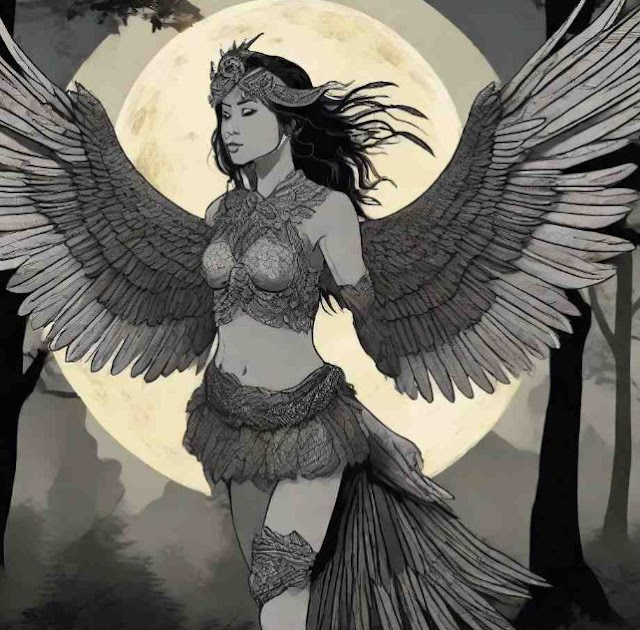MANDURUGO
 |
| Mandurugo |
The mandurugo in Bicol mythology are beautiful vampiric creatures with faces of beautiful women but the body of large bird of prey.
In Philippine oral mythology, the Mandurugo is a mythical being akin to a vampire. The Mandurugo is a type of Aswang, a Filipino shapeshifter. This creature, with harpy-like features, appears as a young and beautiful woman during the day. However, at night, it transforms, developing wings and long, sharp tongues. These tongues are used either to make cuts on a man's neck or to prick the inside of his mouth while kissing, extracting blood.The stories about Mandurugo, prevalent among Tagalog and Bicol speakers, have diverse variations. In some accounts, Mandurugo deceives unsuspecting men by marrying them to prey upon them. Alternatively, she may choose a single husband, using him as a cover for her blood-drinking activities, flying to other villages to feed. In Bicolano stories, Mandurugo is portrayed as large birds of prey with the faces of beautiful maidens hunting for blood.
 |
| madurugo |
 |
| MANDURUGO |
The transformation and synchronization of the Kinari into a Mandurugo
On the other hand, the Kinnara, mythical creature in Philippine mythology, has almost faded from memory. These beings are depicted as beautiful androgynous winged creatures with slender bodies and bird-like lower parts. Originating from Hindu-Buddhist traditions around 200 to 300 CE, the Kinnara symbolized divine beauty and devotion in pre-colonial times. However, during Spanish colonization, they were distorted into blood-drinking harpy-like monsters, reflecting the clash between indigenous beliefs and external influences.
In contemporary stories the Kinari turns into a Mandurugo. The kinari is loyal and subservient as it is beautiful and will love a mortal with all its heart but when the mortal's love is not pure. the Kinari will turn into a harpy-like blood thristy Mandurugo.
 |
| KINARI |
 |
| MADURUGO as portayed in the Animeted series Blade |
MANDURUGO
Transformation into a Monstrous Entity:
Foreign and Colonial Distortion
However, with the arrival of Spanish colonizers, the narratives surrounding the Kinnara underwent a drastic transformation. The Spanish, unable to comprehend the depth of love and devotion embedded in Filipino culture, sought to impose their own values and perceptions. Consequently, the once benevolent and ethereal Kinnara was transformed into a blood-drinking monster, a manifestation of lust, seduction, and horror.
 |
| Mandurugo |
 |
| kinari statue in Thailand |
Transformation into Mandurugo
Foreign brainwaishing
The Kinnari's transformation into the Mandurugo, a blood-sucking creature with harpy-like characteristics, epitomizes the distortion imposed by external forces. The narrative shifted from a creature of love and beauty to a night-stalking horror. The Spanish colonial lens projected notions of lust, seduction, and blood-drinking onto the Kinnari, culminating in the creation of the Mandurugo. This transformation not only reflected the clash of cultural perceptions but also showcased the power dynamics inherent in the process of colonization.
The evolution of the Kinnari into the Mandurugo serves as a poignant example of how cultural narratives can be manipulated during times of colonization. The clash between indigenous beliefs and external influences, driven by religious and cultural differences, reshaped the once benevolent and beautiful Kinnara into a monstrous entity. This transformation underscores the resilience of mythologies in the face of external pressures, while also highlighting the profound impact of colonial forces on the rich tapestry of Philippine folklore.
MANDURUGO
 |
| Mandurugo |
 |
| Mandurugo in Blade animeted series |
The journey of the Kinnara from a divine symbol of beauty and devotion to a monstrous entity encapsulates the complex interplay between cultural influences, colonization, and the reshaping of indigenous narratives. Despite the distortion imposed by external forces, the original essence of the Kinnara remains embedded in the historical artifacts and stories, serving as a reminder of the resilience of mythologies in the face of cultural change. The tale of the Kinnara stands as a testament to the dynamic nature of folklore and the intricate dance between tradition and adaptation in the rich tapestry of Philippine mythology.
 |
| MANDURUGO |
.JPG) |
| MANDURUGO |
.JPG) |
| MANDURUGO |
MANDURUGO ASWANG
.JPG) |
| MANDURUGO |
.JPG) |
| MANDURUGO |
.JPG) |
| MANDURUGO |
.JPG) |
| MANDURUGO |
.JPG) |
| MANDURUGO |
.jpeg) |
| Mandurugo Aswang |
.JPG) |
| MANDURUGO |
REMINDER
The orally transmitted mythology of the Philippines is intended for sharing and understanding, should not be taken literally. not for appropriation, commercial exploitation, or the promotion of foreigners and foreign products. It is a dynamic narrative tradition that evolves over time, distinct from the standardized mythologies found in Western and European cultures. Unlike these established mythologies, the Philippine government has not mandated standardized versions of stories and legends.
Orally transmitted stories undergo variations and evolve over time, resulting in numerous different versions. There are many different version told by Filipinos,and retold by Filipinos. Support Local story tellers
.jpeg)
.jpeg)
.jpeg)



.jpeg)
.jpeg)

No comments:
Post a Comment
Note: Only a member of this blog may post a comment.